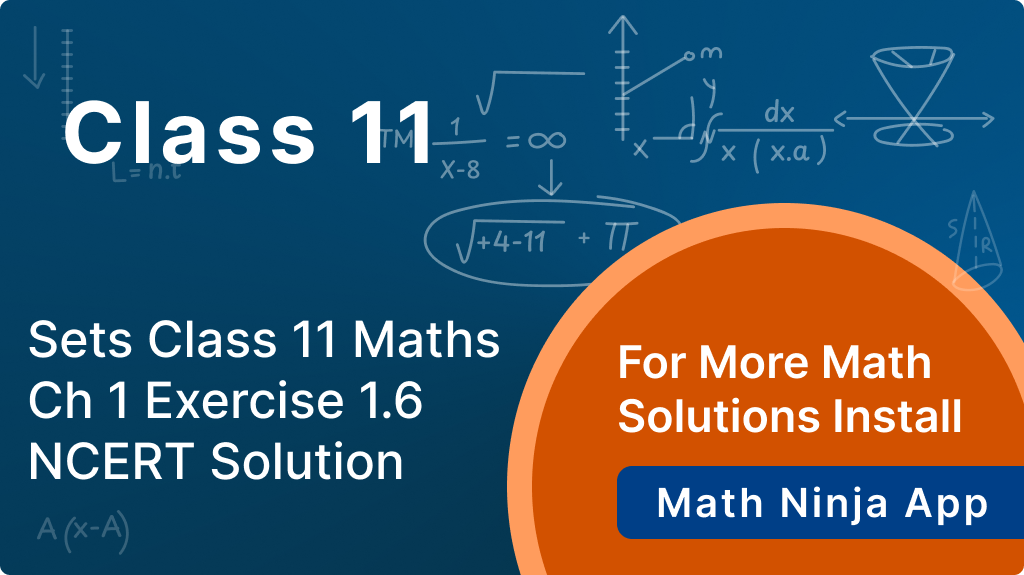exercise 1.6 class 11 maths | class 11 ch 1 exercise solutions | class 11 chapter 1 exercise solution | sets class 11 ncert solutions | ncert solution for class 11 maths chapter 1 | ncert exemplar class 11 maths
Looking for NCERT Class 11 Maths Exercise 1.6 solutions? You’re at the perfect place! This section provides accurate and step-by-step solutions to all the questions from Exercise 1.6 of Chapter 1 – Sets. This exercise focuses on applying set theory to practical problems, using formulas like the principle of inclusion and exclusion. These Class 11 Maths NCERT solutions are ideal for students who want to strengthen their problem-solving skills and gain full clarity on set operations. Whether you’re preparing for exams or daily practice, these solutions will help you grasp the concepts effectively. Download or browse the solutions now and sharpen your understanding of sets!

ncert solution for class 11 maths chapter 1 || exercise 1.6 class 11 maths || class 11 chapter 1 exercise solution || sets class 11 ncert solutions || ncert exemplar class 11 maths || class 11 ch 1 exercise solutions
Exercise 1.6
1. If X and Y are two sets such that \( n(x)=17, \mathrm{n}(y)=23 \) and \( n(x \cup \) \( y)=38 \), find \( n(x \cap y) \).
Answer
It is given that:
\(\mathrm{n}(x)=17, \mathrm{n}(y)=23, \mathrm{n}(x \cup y)=38\)
\(\mathrm{n}(x \cap y)=\text { ? }\)
We know that:
\(n(X \cup Y)=n(X)++n(Y)-n(X \cap Y)\)
\(= 38=17+23-n(X \cap Y)\)
\(= n(X \cap Y)=40-38=2\)
\(= n(X \cap Y)=2\)
ncert solution for class 11 maths chapter 1 || exercise 1.6 class 11 maths || class 11 chapter 1 exercise solution || sets class 11 ncert solutions || ncert exemplar class 11 maths || class 11 ch 1 exercise solutions
2. If X and Y are two sets such that \( x \cup y \) has 18 elements, X has 8 elements and Y has 15 elements; how many elements does \( x \cap y \) have?
Answer
It is given that:
\(=\mathrm{n}(x \cup y) 18, \mathrm{n}(x)=8, \mathrm{n}(y)=15\)
\(\mathrm{n}(x \text { if? } y)=\text { ? }\)
We know that:
\(=\mathrm{n}(x \cup y)=\mathrm{n}(x)+\mathrm{n}(y)-\mathrm{n}(x \cap y)\)
\(18=8+15-\mathrm{n}(x \cap y)\)
\(=\mathrm{n}(x \cap y)=23-18=5\)
\(\mathrm{n}(x \cap y)=5\)
3. In a group of 400 people, 250 can speak Hindi and 200 can speak English. How many people can speak both Hindi and English?
Answer
Let H be the set of people who speak Hindi, and E be the set of people who
speak English
\(\therefore \mathrm{n}(\mathrm{H} \cup \mathrm{E})=400, \mathrm{n}(\mathrm{H})=250, \mathrm{n}(\mathrm{E})=200 \mathrm{n}(\mathrm{H} \cap \mathrm{E})=\text { ? }\)
We know that:
\( n(H \cup E)=n(H)+n(E)-n(H \cap E) \)
\(\therefore 400=250+200-\mathrm{n}(\mathrm{H} \cap \mathrm{E})\)
\(\Rightarrow 400=450-\mathrm{n}(\mathrm{H} \cap \mathrm{E}) \Rightarrow \mathrm{n}(\mathrm{H} \cap \mathrm{E})=450-400\)
\(\therefore \mathrm{n}(\mathrm{H} \cap \mathrm{E})=50\)
Thus, 50 people can speak both Hindi and English.
ncert solution for class 11 maths chapter 1 || exercise 1.6 class 11 maths || class 11 chapter 1 exercise solution || sets class 11 ncert solutions || ncert exemplar class 11 maths || class 11 ch 1 exercise solutions
4. If \( S \) and \( T \) are two sets such that \( S \) has 21 elements, \( T \) has 32 elements, and \( \mathrm{S} \cap \mathrm{T} \) has 11 elements, how many elements does \( \mathrm{S} \cup \mathrm{T} \) have?
Answer
It is given that: \( \mathrm{n}(\mathrm{S})=21, \mathrm{n}(\mathrm{T})=32, \mathrm{n}(\mathrm{S} \cap \mathrm{T})=11 \)
We know that: \( \mathrm{n}(\mathrm{S} \cup \mathrm{T})=\mathrm{n}(\mathrm{S})+\mathrm{n}(\mathrm{T})-\mathrm{n}(\mathrm{S} \cap \mathrm{T}) \)
\(\therefore \mathrm{n}(\mathrm{S} \cup \mathrm{T})=21+32-11=42\)
Thus, the set \( (\mathrm{S} \cup \mathrm{T}) \) has 42 elements.
5. If \( X \) and \( Y \) are two sets such that \( X \) has 40 elements, \( X \cup Y \) has 60 elements and \( x \cap y \) has 10 elements, how many elements does Y have?
Answer
It is given that: \( \mathrm{n}(x)=40, \mathrm{n}(x \cup y) \)
\(=60\)
\( \mathrm{n}(x \cap y)=10\)
\( \text { We know that: }\)
\(\mathrm{n}(x \cup y)=\mathrm{n}(x)+\mathrm{n}(y)-\mathrm{n}(x \cap y) \)
\(\therefore 60=40+\mathrm{n}(y)-10\)
\(\therefore \mathrm{n}(y)=60-(40-10)=30\)
Thus, the set Y has 30 elements.
6. In a group of 70 people, 37 like coffee, 52 like tea and each person likes at least one of the two drinks. How many people like both coffee and tea?
Answer
Let C denote the set of people who like coffee, and T denote the set of people
who like tea \( \mathrm{n}(\mathrm{C} \cup \mathrm{T})=70, \mathrm{n}(\mathrm{C})=37, \mathrm{n}(\mathrm{T})=52 \)
We know that:
\(\mathrm{n}(\mathrm{C} \cup \mathrm{T})=\mathrm{n}(\mathrm{C})+\mathrm{n}(\mathrm{T})-\mathrm{n}(\mathrm{C} \cap \mathrm{T}) \therefore 70=37+52-\mathrm{n}(\mathrm{C} \cap \mathrm{T})\)
\(\Rightarrow 70=89-\mathrm{n}(\mathrm{C} \cap \mathrm{T})\)
\(\Rightarrow \mathrm{n}(\mathrm{C} \cap \mathrm{T})=89-70=19\)
Thus, 19 people like both coffee and tea.
7. In a group of 65 people, 40 like cricket, 10 like both cricket and tennis. How many like tennis only and not cricket? How many like tennis?
Answer
Let C denote the set of people who like cricket, and T denote the set of people
who like tennis
\(\therefore \mathrm{n}(\mathrm{C} \cup \mathrm{T})=65, \mathrm{n}(\mathrm{C})=40, \mathrm{n}(\mathrm{C} \cap \mathrm{T})=10\)
We know that:
\( \mathrm{n}(\mathrm{C} \cup \mathrm{T})=\mathrm{n}(\mathrm{C})+\mathrm{n}(\mathrm{T})-\mathrm{n}(\mathrm{C} \cap \mathrm{T}) \)
\(\therefore 65=40+\mathrm{n}(\mathrm{T})-10\)
\(\Rightarrow 65=30+\mathrm{n}(\mathrm{T})\)
\(\Rightarrow \mathrm{n}(\mathrm{T})=65-30=35\)
Therefore, 35 people like tennis.
Now,
\((\mathrm{T}-\mathrm{C}) \cup(\mathrm{T} \cap \mathrm{C})=\mathrm{T}\)
Also,
\((\mathrm{T}-\mathrm{C}) \cap(\mathrm{T} \cap \mathrm{C})=\phi\)
\(\therefore \mathrm{n}(\mathrm{T})=\mathrm{n}(\mathrm{T}-\mathrm{C})+\mathrm{n}(\mathrm{T} \cap \mathrm{C})\)
\(\Rightarrow 35=\mathrm{n}(\mathrm{T}-\mathrm{C})+10\)
\(\Rightarrow \mathrm{n}(\mathrm{T}-\mathrm{C})=35-10=25\)
Thus, 25 people like only tennis.
8. In a committee, 50 people speak French, 20 speak Spanish and 10 speak both Spanish and French. How many speak at least one of these two languages?
Answer
Let F be the set of people in the committee who speak French, and S be the set of people in the committee who speak Spanish
\(\therefore \mathrm{n}(\mathrm{F})=50, \mathrm{n}(\mathrm{S})=20, \mathrm{n}(\mathrm{S} \cap \mathrm{F})=10\)
We know that:
\( \mathrm{n}(\mathrm{S} \cup \mathrm{F})=\mathrm{n}(\mathrm{S})+\mathrm{n}(\mathrm{F})-\mathrm{n}(\mathrm{S} \cap \mathrm{F}) \)
\(=20+50-10\)
\(=70-10=60\)
Thus, 60 people in the committee speak at least one of the two languages.

